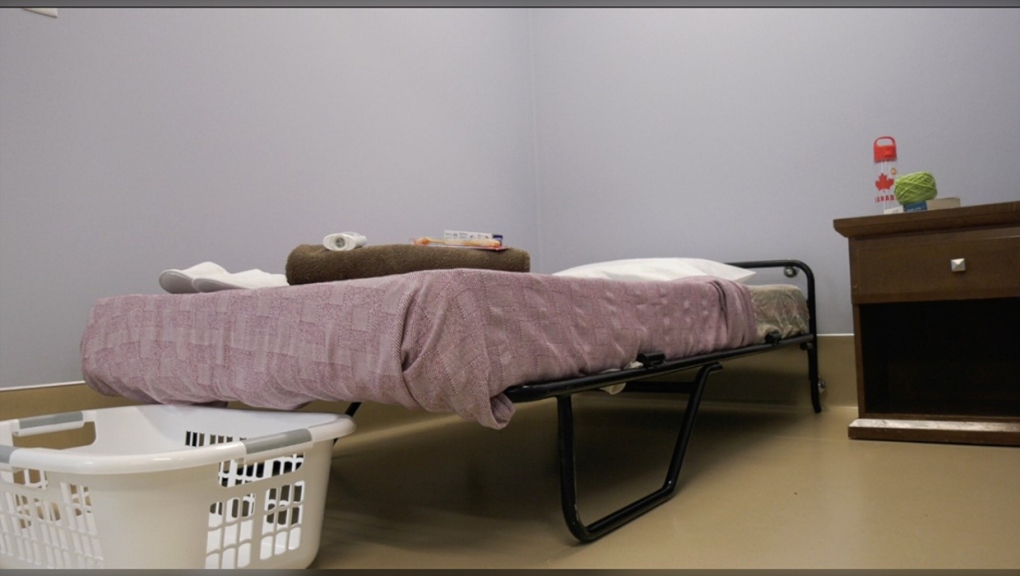Drop In Centre opens 35 withdrawal and recovery beds to combat rising drug poisonings
More than 1,200 drug poisonings occurred inside or around the Drop In Centre between January and April of this year, according to the facility’s executive director.
“Overdoses or drug poisonings that we are experiencing in this building on a daily basis is alarming,” said Sandra Clarkson.
The centre has now renovated its fifth floor to accommodate 35 beds focused on withdrawal management and recovery transition.
“We’re hopeful that we'll be able to serve up to 1000 people a year in both of these programs, helping them find their way on the path to recovery, treatment, and ultimately housing,” said Clarkson.
The programs began in April and are currently operating at a third capacity as renovations are set to be completed.
Come early July, the centre expects all 35 beds will be filled, the majority from those who use the facility’s main purpose, the emergency shelter.
“Once we're fully open, we do feel that the demand is there,” said Clarkson.
“It doesn't take away from shelter beds or the capacity because we're (an) emergency shelter first and foremost. So we anticipate that many of the individuals that are accessing these programs are already in shelter.”
The 15 withdrawal medically-supported detox beds will see clients use those between five and 10 days.
 The 20 recovery beds can be used by a client up to three months.
The 20 recovery beds can be used by a client up to three months.
The 20 recovery beds can be used by a client up to three months.
On Wednesday, shelter staff say about 423 people used the facility for housing, but have the capacity of around 1,000.
A former drug user who is now 16 years sober, Matthew Allaby, is seeing success in the early days of the program.
“I would hope so,” he said.
“I mean, it looks like what they've got going on in detox right now is working.”
Allaby spoke with CTV news in March detailing the level of ‘inhumane’ conditions clients were subject to, including needles in water fountains, clogged toilets, broken mirrors and sinks in the washrooms on floors two and three.
He says staff have stepped up to stop any open air drug use inside the building.
“They did put a clamp on, people smoking drugs inside the building at the tables,” said Allaby.
“They started handing out bars for it.”
 The Newly Institute currently serves about 20-40 clients monthly struggling with trauma, PTSD, anxiety and addiction.
The Newly Institute currently serves about 20-40 clients monthly struggling with trauma, PTSD, anxiety and addiction.
THE NEWLY INSTITUTE
With poisonings growing around the centre, those in need of help have other options.
The Newly Institute currently serves about 20-40 clients monthly struggling with trauma, PTSD, anxiety and addiction.
The facility offers intensive patient programs on a path to recovery.
“One to one therapy, working through those underlying root causes of addiction and substance use, but also in some group education sessions as well too,” said Kyle Horvath, manager of clinical services.
“So learning different skills and frameworks to help individuals get well and stay well.”
Horvath says their clients generally spend five days a week for four weeks and six to seven hours a day going through therapy sessions, strategies to lead them back on a path of sobriety.
“When you look at our substance and addictions program, that can be very isolating illness or disease or challenges,” he said.
“And then when you're even further removed from supports or from connections, it really made it difficult for a lot of individuals. So we're happy to help and kind of dive in and work through some of that, then get people back on track, back engaged in their connections or engaged in their supports.”
CTVNews.ca Top Stories

Parts of Canada could see the Northern Lights on New Year's Eve. Here's where you could see
While fireworks have become a popular way to celebrate the arrival of the new year, many Canadians could be treated to a much larger light display across the night sky.
Ottawa family returns home after chaotic Costa Rica trip
After spending almost 48 hours longer than intended in Costa Rica, the Sachs family has finally returned home.
'Dangerous person alert' ended as police locate dead suspect in Calgary double murder
The suspect in a double homicide that took place in Calgary on Sunday night has been discovered dead by police.
More than US$12M worth of jewelry and Hermes bags stolen from U.K. home
Police are searching for a burglar who stole more than £10 million ($12.5 million) worth of bespoke jewelry in north-west London in what is thought to be one of the biggest thefts from a British home.
Border agents seize $2M worth of cocaine bound for Canada at Coutts
Authorities at the Coutts, Alta., border crossing seized 189 kilograms of cocaine, with an estimated value of about $2 million, that was being shipped into Canada.
Matthew Gaudreau's widow welcomes their first child months after his death
Four months after his death, the widow of Matthew Gaudreau announced the birth of their first child. Gaudreau, 29, and his NHL star brother Johnny Gaudreau, 31, were killed after being struck by a driver in August.
'McDonald's wouldn't open': Here are B.C.'s 10 worst 911 nuisance calls of the year
What do overripe avocados, stinky cologne and misplaced phones have in common? Generally speaking, none of them warrant a call to 911.
Man who peed on B.C. RCMP detachment injured during arrest, watchdog says
A police watchdog is asking witnesses to come forward after a man who allegedly peed on a B.C. RCMP detachment "sustained an injury" during his arrest.
opinion Tom Mulcair: Grading Trudeau's performance in 2024, and what's ahead for him in the new year
Prime Minister Justin Trudeau is about to enter the final year of his mandate and, quite possibly, of his political career, writes Tom Mulcair in his column for CTVNews.ca. The former NDP leader takes a snapshot of Trudeau's leadership balance sheet as a way of understanding how he got to where he is in the polls.

































